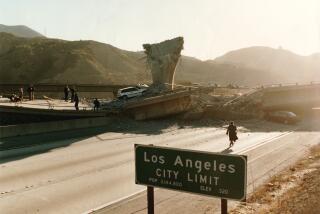George W. Housner dies at 97; Caltech professor emeritus was called the father of earthquake engineering
George W. Housner, who pioneered the modern field of earthquake engineering, developing the most complete mathematical system to analyze the effects of ground shaking on structures, has died. He was 97.
Housner, the Braun professor emeritus of engineering at Caltech, died of natural causes Monday at a Pasadena rest home.
His interest in earthquake engineering was spurred by the March 10, 1933, earthquake in Long Beach, which was later estimated at magnitude 6.3. Brick buildings with unreinforced masonry walls, including many school buildings, failed catastrophically. Although 115 people were killed, the number of deaths would have been even higher if the quake, which hit at 5:55 p.m., had struck during school hours.
According to Tom Heaton, professor of engineering seismology at Caltech and a former colleague of Housner’s, the field of earthquake engineering hardly existed at the time.
“Nothing was mentioned in engineering books regarding designing to resist earthquakes,” Housner told The Times in a 1999 interview.
At the most, Heaton said, engineers considered only how a building would fare in a quake by calculating the force of the pushing on it. It took Housner to realize that an earthquake “is not static” but sets off vibrations throughout the entire structure that could bring it down. Housner developed the mathematical framework to understand those vibrations, which led to the implementation of more rigorous building standards nationwide, Heaton said.
To many in the field today, Housner is known as the father of earthquake engineering, a vigorous subdiscipline of civil engineering.
“George was a man of great intellect, which he used diligently to reduce the impact of earthquakes on our society,” Heaton said. “He was one of those people who changed our world.”
John Hall, professor of civil engineering at Caltech, said Housner ranks with the greatest minds in engineering history. “He could look at a problem no one had ever thought about before and come up with a way to apply basic principles to find a practical solution.”
Born Dec. 9, 1910, in Saginaw, Mich., Housner earned a bachelor’s degree in structural engineering at the University of Michigan.
Arriving at Caltech only months after the Long Beach quake, Housner obtained his master’s and doctorate there, studying under Romeo Martel, who had done some of the earliest work in trying to understand how earthquakes affected buildings.
After graduating from Caltech, Housner went to work for the Army Corps of Engineers, then advised the Army Air Forces during World War II. His work helped bomber pilots improve their success in attacking bridges.
He also devised a plan to counter the barrage balloons that Axis armies sent aloft over Europe’s vulnerable oil fields to interfere with enemy aircraft. Bomber pilots were afraid to attack the oil fields for fear the wires attached to the balloons would slice through their wings. According to Hall, Housner’s calculations that the wires might cut into the wings but would not slice all the way through, gave the Army Air Forces the confidence to make the attacks.
Examination of planes returning from bombing runs proved Housner correct. The wings were grooved, but intact.
In 1945, Housner was given the Distinguished Civilian Service Award by the U.S. War Department in recognition of his contributions to the war effort.
After the war, Housner returned to Caltech as an assistant professor of applied mechanics. He later became the Braun professor before retiring in 1981. In 2006, he was named a Distinguished Alumnus, the highest honor the institute can bestow on graduates.
Housner’s interest in seismic engineering continued after the war; he chaired a National Academies of Sciences committee looking into the damage from the 1964 Alaska earthquake.
He also was instrumental in the design of California’s statewide water storage and transportation system. His earthquake engineering techniques were used to strengthen dozens of dams and aqueducts built throughout California, a system that ranks high among the most ambitious engineering efforts in history.
After the 1989 Loma Prieta quake in Northern California, Gov. George Deukmejian asked Housner to chair the board investigating the collapse of freeways and bridges.
Housner was elected to the National Academy of Sciences in 1972 and became a founding member of the Earthquake Engineering Research Institute. A medal in Housner’s name is awarded each year by the organization.
He also was instrumental in the formation of the International Assn. for Earthquake Engineering, as well as Caltech’s Earthquake Research Affiliates.
In 1981, Housner received the Harry Fielding Reid Medal of the Seismological Society of America. Previous winners included Charles Richter, creator of the Richter scale that measures earthquake severity.
In a 1988 White House ceremony, President Reagan gave Housner the National Medal of Science, recognizing “his profound and decisive influence on the development of earthquake engineering worldwide. His research contributions have guided the development of earthquake engineering and have had an important impact on other major disciplines.”
According to Heaton, even after his retirement, Housner continued to show up each day at his Caltech office. Heaton recalled a time in the late 1990s when he was about to give a lecture on a particularly thorny topic and was having trouble mastering it.
“George was walking by my office,” Heaton said, “so I asked his advice.”
“It’s been a long time since I thought about that,” Housner said, and walked off.
“Five minutes later, he came back, picked up the chalk and wrote out the whole answer,” Heaton said. “I thought, ‘Wow.’ He was 88 at the time.”
Housner never married. He will be buried at Mountain View Cemetery in Altadena.
Johnson is a Times staff writer.






